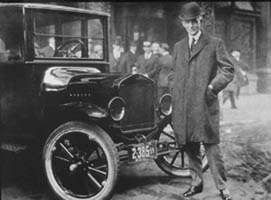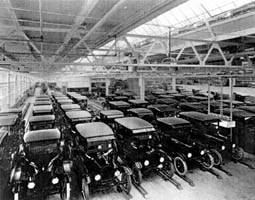
BRINQ is the home of entrepreneur and product designer Patrick Donohue, whose work focuses on high impact startups and products.
Base of the Pyramid ventures must find ways to embed themselves in their markets, capturing and leveraging local knowledge and shifts in perception, and to continue evolving their product and service offerings with their customers.


The Ford Model T: Available in any color as long as it's black.
In 1908, Henry Ford introduced the Ford Model T, a "car for the common man", which both created and dominated the modern automobile market for the next 20 years, with more than 15 million units sold in its lifetime. Ford, however, failed to read the changes in perception of the market he had created, and continued to offer only one model to an evolving market looking for upgrades. The upstart General Motors capitalized on this shortcoming and surpassed Ford and the seemingly unbeatable Model T, by providing a ladder of car brands and upgrades. Some argue that Ford never really recovered from that misstep. This trap of not understanding and capturing the future value a venture enables we dubbed the “Model T Trap”*.
The “Model T Trap” is a critical issue for Base of the Pyramid (BOP) ventures, which by nature are enabling ventures, offering products and services “for the common man”. By enabling progress in the BOP, these ventures run the risk of lifting the customers they serve up and beyond the very services the ventures provide, potentially allowing others to capitalize on that future value, as GM did with Ford. Admittedly, falling into the trap itself is initially a sign of success both for the company and BOP development, but for ventures looking to attract continued investment to the BOP, they must have plans to capture the current AND future value their efforts enable.
This is even more critical if your goal is to incubate disruptive innovations in the Base of Pyramid. As Clayton Christensen details in "The Innovator's Dilemma", before an innovation can disrupt its mainstream competitor, the innovation first incubates in an emerging market that values its attributes (attributes which are initially considered inferior by the mainstream). The innovation then follows an upward climb of improvements to eventually disrupt the mainstream market. That upward climb is a series of steps driven by customer demands in the emerging market. If you are not improving in step with your customer's demands or you are unaware of the innovative ways in which your customers are using your offering, your unlikely to understand which aspects of your innovation are disruptive.
To avoid the trap, BOP ventures must find ways to embed themselves in their markets, capturing and leveraging local knowledge and shifts in perception, and to continue evolving their product and service offerings with their customers. Most critical is understanding how your customers are using your products and capitalizing on the new opportunities and innovations they are creating.
*The "Model T Trap" was presented at the 2004 meeting of the Base of the Pyramid Learning Lab, included in our recommendations for a consulting project to the Grameen Technology Center on the MTN villagePhone venture in Uganda.